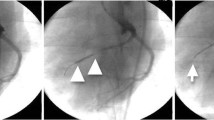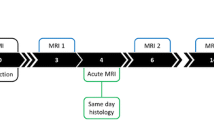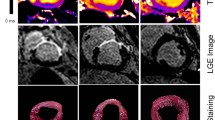Abstract
To determine the infarct affinity of a low molecular weight contrast agent, Gd(ABE-DTTA), during the subacute phase of myocardial infarct (MI). Dogs (n = 7) were examined, using a closed-chest, reperfused MI model. MI was generated by occluding for 180 min the Left Anterior Descending (LAD) coronary artery with an angioplasty balloon. DE-MRI images with Gd(ABE-DTTA) were obtained on days 4, 14, and 28 after MI. Control DE-MRI by Gd(DTPA) was carried out on day 27. T2-TSE images were acquired on day 3, 13 and 27. Triphenyltetrazolium chloride (TTC) histomorphometry validated postmortem the existence of infarct. Gd(ABE-DTTA) highlighted the infarct on day 4, but not at all on day 14 or on day 28, following MI. On day 4, the mean ± SD signal intensity (SI) of infarcted myocardium in the presence of Gd(ABE-DTTA) significantly differed from that of healthy myocardium (45 ± 6.0 vs. 10 ± 5.0, P < 0.05), but it did not on day 14 (11 ± 9.4 vs. 10 ± 5.7, P = NS), nor on day 28 (7 ± 1.5 vs. 7 ± 2.4, P = NS). The mean ± SD signal intensity enhancement (SIE) induced by Gd(ABE-DTTA) was 386 ± 165% on day 4, significantly different from mean SIE on day 14 (9 ± 20%), and from mean SIE on day 28 (12 ± 18%), following MI (P < 0.05). The last two mean values did not differ significantly (P = NS) from each other. As control, Gd(DTPA) was used and it did highlight the infarct on day 27, inducing a mean SIE value of 312 ± 40%. The mean SIE on day 3, 13, or 27 did not vary significantly (P = NS) on the T2-TSE images (114 ± 41%, 123 ± 41%, and 150 ± 79%, respectively). Post mortem, the existence of infarcts was confirmed by TTC staining. The infarct affinity of Gd(ABE-DTTA) vanishes in the subacute phase of scar healing, allowing its use for infarct age differentiation early on, immediately following the acute phase.




Similar content being viewed by others

References
Setser R, Bexell D, O’Donnell T, Stillman A, Lieber M, Schoenhagen P, White R (2003) Quantitative assessment of myocardial scar in delayed enhancement magnetic resonance imaging. J Magn Reson Imaging 18(4):434–441
Kim RJ, Fieno DS, Parrish TB, Harris K, Chen EL, Simonetti O, Bundy J, Finn JP, Klocke FJ, Judd RM (1999) Relationship of MRI delayed contrast enhancement to irreversible injury, infarct age, and contractile function. Circulation 100(19):1992–2002
Kim RJ, Wu E, Rafael A, Chen EL, Parker MA, Simonetti O, Klocke FJ, Bonow RO, Judd RM (2000) The use of contrast-enhanced magnetic resonance imaging to identify reversible myocardial dysfunction. N Engl J Med 343(20):1445–1453
Fieno DS, Hillenbrand HB, Rehwald WG, Harris KR, Decker RS, Parker MA, Klocke FJ, Kim RJ, Judd RM (2004) Infarct resorption, compensatory hypertrophy, and differing patterns of ventricular remodeling following myocardial infarctions of varying size. J Am Coll Cardiol 43(11):2124–2131
Kirschner R, Varga-Szemes A, Toth L, Simor T, Suranyi P, Ruzsics B, Kiss P, Toth A, Baker R, Brott BC, Litovsky S, Elgavish A, Elgavish GA (2010) Reinfarction-specific magnetic resonance imaging contrast agent. J Am Coll Cardiol 55(10 Supplement 1):A84.E795–A784.E795
Kirschner R, Toth L, Varga-Szemes A, Simor T, Suranyi P, Kiss P, Ruzsics B, Toth A, Baker R, Brott B, Litovsky S, Elgavish A, Elgavish G (2010) Differentiation of acute and four-week old myocardial infarct with Gd(ABE-DTTA)-enhanced CMR. J Cardiovasc Mag Reson 12(1):22
Ruzsics B, Suranyi P, Kiss P, Brott BC, Elgavish A, Saab-Ismail NH, Simor T, Elgavish GA (2006) Gd(ABE-DTTA), a novel contrast agent, at the MRI-effective dose shows absence of deleterious physiological effects in dogs. Pharmacology 77(4):188–194
Suranyi P, Kiss P, Ruzsics B, Brott BC, Simor T, Elgavish A, Baker RA, Saab-Ismail NH, Elgavish GA (2007) In vivo myocardial tissue kinetics of Gd(ABE-DTTA), a tissue-persistent contrast agent. Magn Reson Med 58(1):55–64
Suranyi P, Kiss P, Brott BC, Simor T, Elgavish A, Ruzsics B, Saab-Ismail NH, Elgavish GA (2006) Percent infarct mapping: an R1-map-based CE-MRI method for determining myocardial viability distribution. Magn Reson Med 56(3):535–545
Ruzsics B, Suranyi P, Kiss P, Brott BC, Elgavish A, Simor T, Elgavish GA (2008) Head-to-head comparison between delayed enhancement and percent infarct mapping for assessment of myocardial infarct size in a canine model. J Magn Reson Imaging 28(6):1386–1392
Saab-Ismail NH, Simor T, Gaszner B, Lorand T, Szollosy M, Elgavish GA (1999) Synthesis and in vivo evaluation of new contrast agents for cardiac MRI. J Med Chem 42(15):2852–2861
Beek AM, Bondarenko O, Afsharzada F, van Rossum AC (2009) Quantification of late gadolinium enhanced CMR in viability assessment in chronic ischemic heart disease: a comparison to functional outcome. J Cardiovasc Magn Reson 11(1):6
Friedrich MG, Abdel-Aty H, Taylor A, Schulz-Menger J, Messroghli D, Dietz R (2008) The salvaged area at risk in reperfused acute myocardial infarction as visualized by cardiovascular magnetic resonance. J Am Coll Cardiol 51(16):1581–1587
Schwitter J, Saeed M, Wendland MF, Derugin N, Canet E, Brasch RC, Higgins CB (1997) Influence of severity of myocardial injury on distribution of macromolecules: extravascular versus intravascular gadolinium-based magnetic resonance contrast agents. J Am Coll Cardiol 30(4):1086–1094
Simonetti OP, Kim RJ, Fieno DS, Hillenbrand HB, Wu E, Bundy JM, Finn JP, Judd RM (2001) An improved MR imaging technique for the visualization of myocardial infarction. Radiology 218(1):215–223
Witte RS, Witte JS (1997) Statistics, 5th edn edn. Harcourt Brace College Publishers, Fort Worth
Saeed M, Weber O, Lee R, Do L, Martin A, Saloner D, Ursell P, Robert P, Corot C, Higgins CB (2006) Discrimination of myocardial acute and chronic (scar) infarctions on delayed contrast enhanced magnetic resonance imaging with intravascular magnetic resonance contrast media. J Am Coll Cardiol 48(10):1961–1968
Abdel-Aty H, Zagrosek A, Schulz-Menger J, Taylor AJ, Messroghli D, Kumar A, Gross M, Dietz R, Friedrich MG (2004) Delayed enhancement and T2-weighted cardiovascular magnetic resonance imaging differentiate acute from chronic myocardial infarction. Circulation 109(20):2411–2416
Kim KA, Seo JB, Do KH, Heo JN, Lee YK, Song JW, Lee JS, Song KS, Lim TH (2006) Differentiation of recently infarcted myocardium from chronic myocardial scar: the value of contrast-enhanced SSFP-based cine MR imaging. Korean J Radiol 7(1):14–19
Johnston D, Homma S, Liu P, Weilbaecher D, Rokey R, Brady T, Okada R (1988) Serial changes in nuclear magnetic resonance relaxation times after myocardial infarction in the rabbit: relationship to water content, severity of ischemia, and histopathology over a six-month period. Magn Reson Med 8(4):363–379
Richard V, Murry CE, Reimer KA (1995) Healing of myocardial infarcts in dogs. Effects of late reperfusion. Circulation 92(7):1891–1901
Hutchins GM, Bulkley BH (1978) Infarct expansion versus extension: two different complications of acute myocardial infarction. Am J Cardiol 41(7):1127–1132
Kim RJ, Chen EL, Lima JA, Judd RM (1996) Myocardial Gd-DTPA kinetics determine MRI contrast enhancement and reflect the extent and severity of myocardial injury after acute reperfused infarction. Circulation 94(12):3318–3326
Mahrholdt H, Wagner A, Holly TA, Elliott MD, Bonow RO, Kim RJ, Judd RM (2002) Reproducibility of chronic infarct size measurement by contrast-enhanced magnetic resonance imaging. Circulation 106(18):2322–2327
Choi KM, Kim RJ, Gubernikoff G, Vargas JD, Parker M, Judd RM (2001) Transmural extent of acute myocardial infarction predicts long-term improvement in contractile function. Circulation 104(10):1101–1107
Fieno DS, Kim RJ, Chen EL, Lomasney JW, Klocke FJ, Judd RM (2000) Contrast-enhanced magnetic resonance imaging of myocardium at risk: distinction between reversible and irreversible injury throughout infarct healing. J Am Coll Cardiol 36(6):1985–1991
Weisman HF, Healy B (1987) Myocardial infarct expansion, infarct extension, and reinfarction: Pathophysiologic concepts. Prog Cardiovasc Dis 30(2):73–110
Acknowledgments
This study was partially supported by National Institutes of Health; Grant Number: 1R41 HL084844. An abstract of this work was presented at the 38th Annual Meeting of the North American Society of Cardiovascular Imaging (NASCI), October 3-5, 2010 Seattle, Washington. A part of this work (the clinical implications paragraphs in the Discussion section) was presented at the 59th Annual Scientific Session of the American College of Cardiology, March 2010, Atlanta, Georgia.
Conflict of interests
Dr. Kirschner and Dr. Varga-Szemes are employees, P. Kiss, P. Suranyi and B. Ruzsics were employees, and Drs. A. Elgavish and G. A. Elgavish are officers, of Elgavish Paramagnetics Inc., as well as employees of UAB.
Author information
Authors and Affiliations
Corresponding author
Rights and permissions
About this article
Cite this article
Kirschner, R., Varga-Szemes, A., Simor, T. et al. Acute infarct selective MRI contrast agent. Int J Cardiovasc Imaging 28, 285–293 (2012). https://doi.org/10.1007/s10554-011-9811-8
Received:
Accepted:
Published:
Issue Date:
DOI: https://doi.org/10.1007/s10554-011-9811-8



